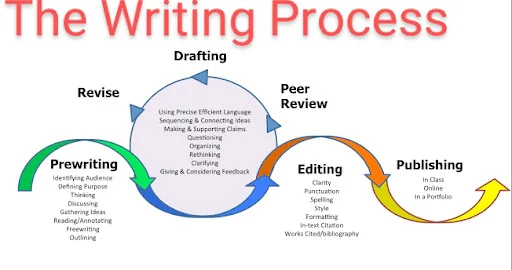Chapter 2: Understanding the Writing Process
Writing is a structured activity that involves multiple stages, each contributing to the clarity and effectiveness of the final product. The writing process ensures that ideas are developed, organized, and communicated efficiently. This chapter explores the essential stages of the writing process, including pre-writing strategies, drafting and revising techniques, and proofreading and editing for clarity and accuracy.
2.1 Pre-writing Strategies
Before beginning a writing project, it is crucial to engage in pre-writing strategies to generate and organize ideas. This stage helps writers clarify their thoughts and establish a strong foundation for their writing.
2.1.1 Brainstorming
Brainstorming is the process of generating ideas freely and spontaneously. It allows writers to explore various perspectives and potential topics without immediate concern for structure or correctness. Co brainstorming techniques include:
-
Freewriting: Writing continuously for a set period to generate ideas without self-editing.
-
Listing: Creating a list of possible topics, themes, or arguments related to the subject.
-
Mind Mapping: Drawing a visual representation of ideas, showing relationships and connections.
-
Questioning: Asking questions such as who, what, when, where, why, and how to explore different aspects of the topic.
2.1.2 Outlining
An outline serves as a roadmap for the writing process, helping to organize ideas in a logical sequence. A well-structured outline includes:
-
Introduction: A brief statement of the topic and thesis.
-
Body Paragraphs: Key points supported by evidence and examples.
-
Conclusion: A summary of the main points and final thoughts. Outlining ensures a coherent flow and prevents disorganization in the writing process.
2.2 Drafting and Revising Techniques
Once the pre-writing phase is complete, writers can move on to drafting and revising. This stage involves creating the first version of the document and making improvements through multiple revisions.
2.2.1 Drafting
Drafting is the process of putting ideas into complete sentences and paragraphs. The focus should be on developing content rather than perfecting grammar or style. Key elements of an effective draft include:
-
A clear thesis statement that guides the entire document.
-
Logical progression of ideas with appropriate transitions.
-
Supporting details that strengthen the main points.
2.2.2 Revising
Revision is an essential step that involves evaluating and improving the draft. Writers should assess:
-
Clarity and coherence: Are the ideas presented logically?
-
Consistency and structure: Do paragraphs follow a logical order?
-
Depth of analysis: Are arguments well-supported with evidence?
-
Word choice and tone: Is the language appropriate for the audience? Revision often involves reorganizing sections, adding details, and eliminating unnecessary information.
2.3 Proofreading and Editing for Clarity and Accuracy
The final stage of the writing process involves proofreading and editing. This step ensures that the writing is polished and free of errors.
2.3.1 Proofreading
Proofreading focuses on identifying and correcting surface-level errors, such as:
-
Grammar and punctuation mistakes
-
Spelling errors
-
Typographical errors
-
Incorrect word usage Effective proofreading strategies include reading the text aloud, using spell-check tools, and reviewing the document multiple times.
2.3.2 Editing
Editing goes beyond proofreading by improving the overall quality of writing. This process involves:
-
Enhancing sentence clarity and structure
-
Eliminating redundancy and awkward phrasing
-
Ensuring consistency in style and tone
-
Fact-checking to maintain accuracy Editing refines the content, making it more engaging and precise.
Conclusion
Understanding the writing process is essential for producing well-structured and compelling written work. By utilizing pre-writing strategies such as brainstorming and outlining, drafting with a clear focus, and revising thoughtfully, writers can develop strong and effective documents. The final steps of proofreading and editing ensure clarity and accuracy, ultimately enhancing the overall quality of the writing. Mastering these techniques leads to more confident and proficient writing in any field.

Comments
Post a Comment
"Thank you for seeking advice on your career journey! Our team is dedicated to providing personalized guidance on education and success. Please share your specific questions or concerns, and we'll assist you in navigating the path to a fulfilling and successful career."